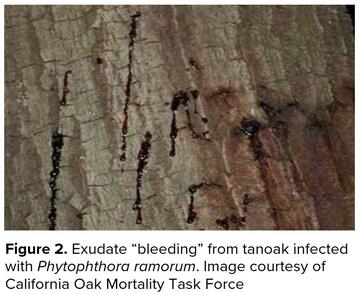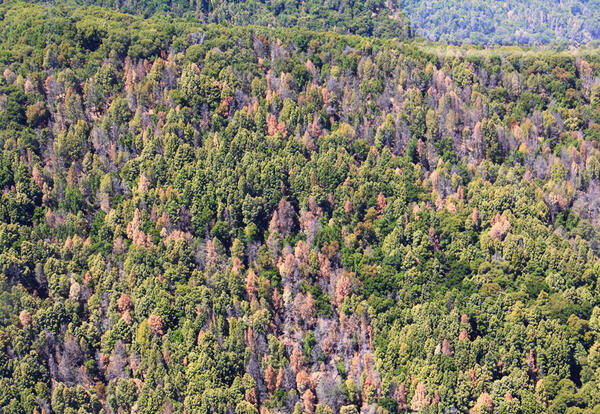Since its characterization in the early 2000’s, Phytophthora ramorum has killed tens of millions of native tanoaks and true oak species across western hardwood forests in the U.S., thereby altering natural ecosystems and carbon sequestration while increasing wildfire risk (Figure 1.) Furthermore, this pathogen has moved throughout Europe and the U.S. and into Canada on infected nursery stock, such as woody ornamental shrubs and understory trees. The lethality of sudden oak death on native species combined with the mobility of ramorum shoot and leaf blight on propagated hosts have caused significant ecological change and turmoil among foresters, ecologists, nursery associations and Federal and state regulatory agencies.
Symptoms of what we now designate as sudden oak death were first observed in the mid-1990’s in Marin County, California. Rapid onset of bleeding stem and trunk cankers, overall decline and death were observed in large numbers of coast live oak (Quercus agrifolia) and tanoak (Lithocarpus densiflorus), two species native to California and Oregon coastal ranges. At that time, etiology was undetermined, but drought, insect pests and opportunistic fungal pathogens were investigated as potential suspects, independently and in ensemble.
In 2000, a seemingly unknown and non-native species of the oomycete pathogen Phytophthora was isolated from canker material and identified as the causal agent of the symptomology observed in California. Shortly thereafter, it was determined this same organism was causing foliar blight, tip blight and stem cankers on nursery-grown rhododendrons and viburnums in Europe, where this discrete, non-lethal symptomology was first observed in the early 1990’s. It is believed that P. ramorum was introduced to Europe and the U.S. in two separate events, apparently on nursery stock. Current research suggests P. ramorum is native to Southeast Asia, but the extent of its endemic range is unknown. The species was named P. ramorum in 2001, due to the branch infection paradigm observed across all symptomologies; ramus is Latin for branch, and ramorum is the genitive plural of ramus. Therefore, Phytophthora ramorum translates to “plant destroyer of branches.”

It is known that P. ramorum infects at least 150 species of herbaceous perennials, cultivated woody ornamentals and native canopy and understory trees and shrubs. For a full list of proven and associated plant hosts, please visit the USDA APHIS website. Symptoms vary by host and exist on a spectrum from lethal to little more than associative sporulation. Furthermore, not all hosts exhibit naturally occurring infections and only through artificial inoculation do symptoms present. Nevertheless, two distinct natural infection strategies have been identified in North America with P. ramorum, and symptomologies are known discretely as sudden oak death and ramorum leaf and shoot blight. In 2009, P. ramorum was identified causing lethal symptoms on Japanese larch (Larix kaempferi) in timber plantations in the UK, and Ireland shortly thereafter. This is known as sudden larch death and exhibits symptoms ostensibly similar to those of the sudden oak death paradigm.
Sudden oak death symptoms manifest as bleeding cankers on the trunks of several members of Fagaceae, including tanoak, coast live oak, and additional species within the Quercus genus. Phytophthora ramorum infects through the outer bark and colonizes the inner bark and phloem of trunk hosts, thereby restricting the movement of photosynthates from source to sink and compromising physical plant defense components. Internal colonization of wood causes resinous, reddish-brown exudate to “bleed” from intact and cracked outer bark, resulting in characteristic external symptomology (Figure 2.). Trunk cankers can enlarge to three meters in length and girdle infected trees, resulting in crown wilting, limb dieback and host mortality, typically within five years of initial infection (Figures 3. and 4.).
Furthermore, infected trees become hosts for opportunistic species of wood-boring beetles and decay fungi, such as Annulohypoxylon thouarsianum. Presently, the sudden oak death pathosystem has been confined to coastal forests in California and Oregon, where USDA quarantines are in effect to limit human-assisted distribution.
Ramorum blight is polycyclic and can affect leaves and stems of multiple species of woody ornamentals and native trees and shrubs, other than those subject to sudden oak death. These are typically referred to as foliar hosts and include species popular in the nursery trade, such as all species and cultivars of Camellia, Kalmia, Pieris, Rhododendron and Viburnum.
Symptoms of ramorum blight include necrotic lesions on leaf surfaces, twig dieback and defoliation on some hosts. Leaf infections can occur through petioles as stem infections move downward from terminal buds, killing woody tissue. Furthermore, foliar infections can appear anywhere on leaf surfaces and are indistinguishable from those caused by additional Phytophthora species and fungal pathogens. This symptomology is not typically lethal on mature hosts. Nevertheless, symptomatic nursery plants such as Rhododendron function as vehicles of pathogen dissemination and potential sources of primary inoculum in areas beyond current sudden oak death epidemics, e.g., Midwest and eastern U.S. hardwood forests (Figure 5.).
Natural dispersal of P. ramorum inoculum in forests occurs via splashing water and wind currents, moving from sporulating foliar hosts to trunk hosts. In the U.S., the primary foliar host in western forests is the California bay laurel (Umbellularia californica) (Figure 6.). Most trunk hosts are considered dead ends, as sporulation does not occur, and infections are lethal. Nevertheless, foliar sporulation is known to occur on tanoak and Japanese larch. Human-assisted dispersal of inoculum is via movement of infested soil on equipment, vehicle tires and shoes and infested firewood, mulch and timber products outside of regions under quarantine. Interstate and international movement of infected nursery stock is the primary means of long-distance dispersal of P. ramorum. It is believed this is the dispersal paradigm responsible for introduction to both the U.S. and UK in separate events. Phytophthora ramorum is considered a high-risk quarantine pathogen of A2 status in the European and Mediterranean Plant Protection Organization (EPPO). In the U.S., USDA APHIS regulates the movement of nursery stock and restricts movement of forest stock and wood products from areas within quarantine.
Management of P. ramorum and its infection cycles is multi-faceted and requires the coordinated efforts of private industry and government regulatory agencies, local, state and federal. Management protocol includes a combination of material quarantines, eradication of infected hosts and exclusion from areas free of P. ramorum (Figure 7.). The cornerstone of this protocol is successful diagnosis of infections caused by P. ramorum specifically; symptomology on foliar hosts is indistinguishable from that caused by abiotic conditions and foliar pathogens exempt from quarantine status. Therefore, species level diagnosis at intercept locations is indispensable to preventing outbreaks while allowing for the unimpeded movement of nursery products originating within regions of quarantine.
Current identification protocol for P. ramorum can include 1.) genus-level detection in the field on regulated plant tissue with a lateral flow device, 2.) genus-level confirmation in regional laboratories on plant tissue with an ELISA product, and 3.) species identification via approved qPCR technology. Agdia’s new AmplifyRP® XRT assay for identification of Phytophthora ramorum was developed to function as a frontline diagnostic for all links in the regulatory chain. It will provide a new tool for use in the ongoing effort to minimize the human-assisted spread of P. ramorum while simplifying the identification process for regulators and all those who rely on the timely delivery of regulated items as means of income.
AmplifyRP® XRT technology promotes the rapid amplification and detection of nucleic acid targets, DNA or RNA, while maintaining a single operating temperature of 42oC. The AmplifyRP® XRT products achieve target sensitivity and specificity comparable to qPCR while having clear advantages over the lab-based technology. AmplifyRP® XRT products do not require a nucleic acid purification step; crude sample extracts are prepared using a simple extraction buffer and tested directly. This makes the testing process simple and saves the end user valuable time. Furthermore, this facilitates the implementation of this technology at remote locations with limited resources. When paired with Agdia’s AmpliFire® isothermal fluorometer, the XRT system is a rapid, user-friendly tool that can be implemented in the field or the lab by personnel with limited experience in molecular diagnostics (Figure 8.).
Agdia’s new assay is specific for P. ramorum and will detect both European lineages and both North American lineages. This product was validated against a comprehensive panel of potential cross reactors, including numerous species of Phytophthora, Phytopythium and Pythium, and no cross reactions were observed. This product was developed to be used with leaf tissue.
About Agdia
A leading provider of diagnostic solutions for agriculture, Agdia, Inc. has been serving plant breeders, propagators, growers, universities, regulatory organizations and private testing laboratories since 1981. The company offers a comprehensive portfolio of validated, easy-to-use diagnostics for identifying plant pathogens, plant hormones, and transgenic traits. Furthermore, Agdia operates an ISO accredited, in-house, testing services laboratory. For more information on Agdia’s full line of products, visit the company’s website at www.agdia.com
AmplifyRP® and AmpliFire® are registered trademarks of Agdia, Inc.




